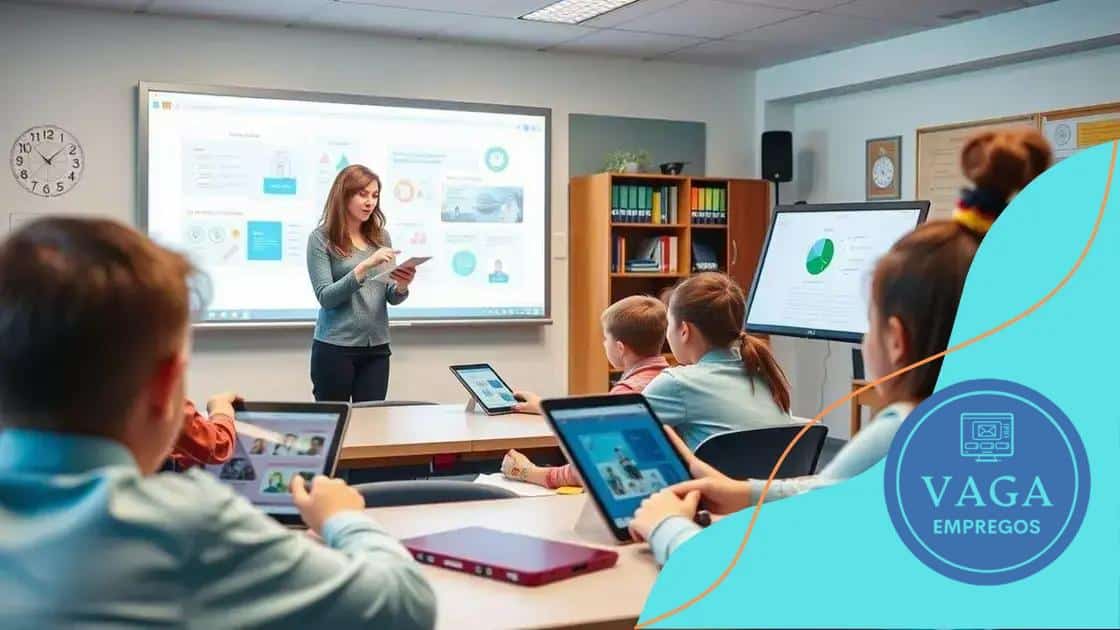Teacher training programs restructured for future needs

Advertisement
Evaluating the effectiveness of teacher training reforms focuses on clear metrics, teacher feedback, and student outcomes, ensuring training meets educators’ needs and enhances student learning.
Teacher training programs restructured for future needs highlight the importance of adapting education to meet the evolving demands of today’s society. How prepared are our teachers to face these challenges? Let’s explore the innovative strategies reshaping their training.
Advertisement
Rethinking teacher training methodologies
Rethinking teacher training methodologies is crucial for preparing educators to meet modern challenges. As classrooms evolve, so must the strategies used to equip teachers with the skills they need.
Advertisement
Innovative Training Techniques
New approaches to training can lead to better educational outcomes. For instance, incorporating hands-on experiences allows teachers to practice skills in real-life scenarios. This method enhances their confidence and effectiveness in the classroom.
Mentorship and Peer Collaboration
Building a support system through mentorship is another powerful method. Experienced teachers can guide newcomers, sharing practical insights and strategies. Peer collaboration fosters a strong community of learning, where teachers can exchange ideas and resources.
- Regular feedback sessions improve teaching techniques.
- Workshops on technology integration can enhance lesson plans.
- Group discussions on student engagement strategies can lead to innovative solutions.
Emphasizing reflective practice is also vital. Encouraging teachers to assess their methods can cultivate continuous improvement. By regularly considering what works and what doesn’t, teachers become more adaptable and effective.
Finally, addressing different learning styles is essential. Training should equip teachers to cater to diverse student needs. This adaptability helps ensure all students thrive in the classroom environment.
Incorporating technology in training programs

Incorporating technology in training programs has become essential for effective teacher preparation. Today’s educators need to be equipped with the latest tools to engage students and enhance learning experiences.
Benefits of Technology Integration
Utilizing technology in training offers numerous advantages. First, it allows for interactive learning, which keeps teachers engaged. Additionally, online resources can provide easy access to training materials, enabling self-paced learning.
Practical Applications
For instance, virtual classrooms and teaching simulations enable future teachers to practice their skills. These practical applications help them understand classroom dynamics better. Furthermore, integrating educational software can streamline lesson planning and delivery.
- Interactive platforms encourage collaborative learning among trainees.
- Digital tools simplify tracking and assessing student progress.
- Using multimedia resources can cater to various learning styles.
Moreover, implementing technology fosters a culture of lifelong learning. Teachers must adapt to new trends and tools throughout their careers. This adaptability is crucial in a rapidly changing educational landscape.
As technology evolves, so too do the methods and strategies for teacher training. It is essential to remain updated on the latest innovations. By leveraging technology effectively, training programs can prepare teachers who are ready to inspire and engage their students.
Fostering collaboration among educators
Fostering collaboration among educators is vital for creating a positive learning environment. By working together, teachers can share insights, strategies, and resources that enhance their teaching practices.
Building a Supportive Community
Creating a supportive community helps educators feel connected. Regular meetings and workshops provide opportunities for teachers to exchange ideas. These interactions can lead to lasting professional relationships that benefit everyone involved.
Team Teaching and Co-Planning
Another effective way to encourage collaboration is through team teaching. When teachers work together in the classroom, they can blend their strengths. This approach allows them to reach a wider range of students and address different learning needs.
- Sharing responsibilities can make lesson implementation smoother.
- Co-planning lessons helps to align teaching methods.
- Joint assessments can provide a broader understanding of student performance.
Furthermore, using digital tools can enhance collaboration. Platforms for sharing documents and resources allow educators to work together more efficiently. Creating online forums for discussion also encourages ongoing professional dialogue.
As collaboration becomes a core part of the culture, teachers can develop new skills and perspectives. This environment nurtures innovation in teaching practices, ultimately benefiting students. When educators collaborate, they are better equipped to tackle challenges and improve student outcomes.
Addressing diverse learner needs

Addressing diverse learner needs is essential in today’s classrooms. Each student comes with unique abilities, backgrounds, and learning styles. By recognizing these differences, educators can provide a more inclusive and effective education.
Understanding Learning Styles
Students absorb information in different ways. Some may learn best through visuals, while others prefer hands-on activities. Understanding these learning styles helps teachers tailor their lessons to reach every student.
Implementing Differentiated Instruction
Differentiated instruction is a key strategy to meet diverse needs. This approach allows teachers to modify content, processes, or products based on student readiness. For example, teachers might offer different reading materials for advanced and developing readers.
- Small group work enables targeted support.
- Using technology can provide personalized learning paths.
- Flexible assessments allow for various demonstration of knowledge.
Moreover, creating a welcoming classroom environment fosters learning. Teachers can encourage collaboration among students from different backgrounds. This interaction enhances understanding and promotes respect for diversity.
Regular feedback is crucial in this process. Educators should assess students’ progress and adjust their methods as needed. Open communication with students can also help identify their changing needs over time.
By taking these steps, teachers ensure that every learner has the opportunity to succeed. Meeting diverse learner needs not only benefits individual students but enhances the classroom experience for everyone.
Evaluating the effectiveness of training reforms
Evaluating the effectiveness of training reforms is crucial to ensure that teacher training programs meet their goals. Regular assessment helps identify what works and where improvements are needed.
Key Metrics for Evaluation
To effectively evaluate training reforms, it is important to establish clear metrics. These metrics can include student performance, teacher satisfaction, and classroom engagement levels. By examining these areas, schools can gain insights into the impact of their training initiatives.
Gathering Feedback
Collecting feedback from teachers is another important aspect. Surveys and interviews can provide valuable information about the training process. This feedback allows educators to express their views and suggest enhancements.
- Feedback can highlight areas of the training that were beneficial.
- Suggestions for improvement can lead to more effective programs.
- Understanding teacher needs can improve future training sessions.
Moreover, it’s essential to look at student outcomes as well. Monitoring changes in student engagement and academic achievements can indicate how well the training reforms are working. Understanding this relationship can guide future training investments.
In addition to quantitative metrics, qualitative assessments can provide deeper insights. Observations of classrooms can show how teachers apply their training in real scenarios. This approach helps to identify whether the skills gained in training translate effectively into practice.
Through continuous evaluation and adjustment, training reforms can become more effective. By focusing on both teacher and student outcomes, educational institutions can ensure their teacher training programs are truly beneficial.
Conclusion
Evaluating the effectiveness of teacher training reforms is essential to ensure that educators receive the best support possible. By focusing on clear metrics, gathering feedback, and monitoring student outcomes, schools can continually improve their training programs. Emphasizing both qualitative and quantitative assessments helps create a comprehensive understanding of the reforms’ impacts. As a result, continuous improvement leads to better teaching practices, which ultimately benefit students and enhance the overall learning environment.
FAQ – Frequently Asked Questions about Evaluating Teacher Training Reforms
Why is evaluating teacher training reforms important?
Evaluating reforms ensures that training programs effectively meet the needs of educators and improve student outcomes.
What metrics should be used for evaluation?
Key metrics include student performance, teacher satisfaction, and classroom engagement levels.
How can feedback from teachers improve training programs?
Collecting feedback allows educators to provide insights on what works and suggest areas for improvement.
What role do student outcomes play in the evaluation process?
Monitoring student outcomes helps determine the real impact of training reforms on classroom effectiveness and learning.





